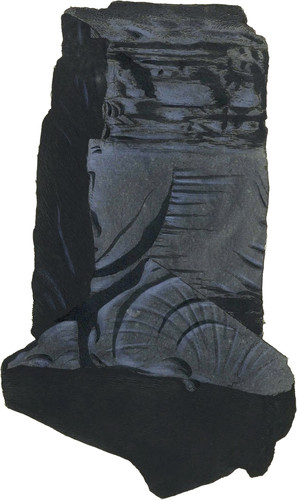 Enlarge
Enlarge
British Mineralogy
Bituminous Coal
- Div. 2. Amorphous.
Cannel Coal, so called in many places from its giving a candle-like flame, and which often serves the poor instead of candles where it is obtained (in Scotland particularly), is only the better sort of what is called Splint Coal at Newcastle, and other places where it is also found. Box Coal is a still finer sort; they all seem to be an intimate mixture of a small portion of Charcoal with Amorphous Bituminous Coal, differing in the state of aggregation from the more general form of Coal, which is alternate layers of Charcoal and crystallized Bituminous Coal, very distinct s they often join each other; the Amorphous occurring 18 inches or more in thickness between strata of the other*. Box Coal is occasionally so very uniform as to serve to turn in a lathe to form boxes. At Wigan in Lancashire, which was famous about half a century since for producing it of a more beautiful grain than any other place, an ingenious turner and mechanic took advantage of his judgement in procuring it and turning boxes of it; carvings of Blackmoors’ heads and other tiling were also made of this Coal about the same time. I have an inkstand and a vase of it: the latter is about 12 inches in circumference, and 5 in height. Both at Wigan and abroad it is occasionally used for beads and other ornamental purposes, and even passes for Jet. I am, however, more surprised that some of our late authors almost confound it with Jet also. The turner or worker of Jet would however soon inform them of a sufficient difference; Jet producing a snuff brown streak or turnings, and the Coal a black powder: besides, the Coal has not the resinous electricity excited by friction, nor the woody texture†.
The lower figure is the copy of a specimen chosen from among Cannel or Splint Coal from Newcastle; it is far from being of the finest or toughest kind. When liable to split and form large fractures, it will not serve for ornamental purposes: its fracture is often curiously circular, variously undulating or otherwise, that is to say, commonly conchoidal. It often shows the Slicken side appearance arising from two faces of a crack in the rock having glided smoothly against each other, leaving a tine polish as on the front of the figure. The best kind for turning is capable of receiving a brilliant polish, but at best it is of a cold grayish black colour (if I may use such terms); as by comparison it is found to have much less richness in effect than the fine warm or brown black of Jet. Sometimes it is very solid, at others it is much rifled or full of cracks, which are often filled with Carbonate of Lime, &c. when in the pit.
The upper figure shows a stratum of Splint with common Coal above and below it; it shows the tendency to the rhomboklal prism in Coal, and the rather peculiar curved and conchoidal fracture.
This Coal is excellent fuel, but if thrown immediately upon a clear tire, it splits and flies about—whence its name. Its good qualities are now so well known and esteemed, that the greater the quantity mixed among other coals, the higher is their price.
- * It has been found so large as to be turned into plates, and a number were once turned to supply a feast; they were burnt afterwards to surprise and warm the company, who had no suspicion that plates which were used as if black earthen-ware, could be combustible and flame.
- † Stone Coal, (tab.
408410.‡) which often has precisely the appearance, fracture, &c. either of the Splint or of the more common bituminous Coal of Newcastle, has, I am told, been found in South Wales fit for turning: perhaps it has been used to be turned into boxes occasionally, it may then be denominated Blind or Stone Box Coal in contradistinction to Blazing Cox Coal. I do not know that it has been turned into plates like the other. If however it have, and they were to he put upon the fire, they would not blaze, and therefore might appear only to heat red hot like earthen-ware. It may be worthy of remembrance, that the soft Charcoal may occasionally alternate with the more solid parts of Stone Coal, in the same way as it docs in the Newcastle and other Bituminous Coal; and the Stone Coal has sometimes a greasy or bituminous appearance, and yet is nearly a pure Carbon that will not flame. I have such from Ireland. - ‡ Reproduction note: The original text references tab. 408 but Stone Coal is illustrated in tab. 410.

